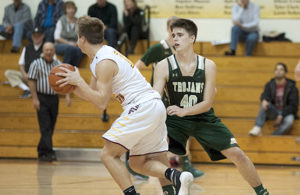Strong feeder systems bring long-term success
The job of a varsity high school basketball coach can best be compared to an iceberg.
The most visible part of a coach’s job is leading the team during games. Much like an iceberg sticking above water, that’s what everyone sees. It’s the subject of most of the praise, criticism and second-guessing from fans, parents, school board members and the administration.
But the part most people don’t see, or care to think about, is what lies beneath the water. One of those responsibilities is putting together and overseeing a program’s feeder system.For all the time and effort a coach puts into running his or her team during the season, the groundwork they lay for their squads in the lower grades could have just as big of an impact on their success — and job security — for years to come.
Legendary Green Bay Packers coach Vince Lombardi said, “The difference between a good coach and an average coach is knowing what you want and knowing what the end is supposed to look like. If a coach doesn’t know what the end is supposed to look like, he won’t know it when he sees it.”
So what’s the end? Or, put another way, what’s the goal? You can’t create a good plan if you don’t have a clearly articulated goal, and it’s almost impossible to reach any worthwhile goal without a clear vision on how you’ll get there.
The goals vary from coach to coach. The nuts and bolts are based on the coach’s individual philosophy, which should be flexible and adjusted to fit his or her personnel. Otherwise, the coach is just setting up their players to fail at the expense of their egos.
» SEE: Leaving your coaching mark on the team
One could argue the value of obsessing over whether learning the same plays as the varsity team should be a priority over developing a general aptitude for the game. Some top coaches certainly favor the latter. But let’s look past the Xs and Os and consider this: What kind of players do we hope to develop?

The main goals of your feeder system should be to develop players who are fundamentally sound, play and practice with great effort, and have high basketball IQs.
If you tell a varsity coach he or she will welcome players in their program each year who have those three traits, most would be ecstatic. And while it’s true your in-season work will yield only limited results without players who work hard during the offseason, let’s look at a few of the many ways you can work toward these goals.
Reinforcing fundamentals
This is obvious for many coaches. It’s not difficult to identify whether a player can dribble, pass, shoot or catch. If your players exhibit poor fundamentals, get ready for a long season.
Improving skill isn’t complicated, and it isn’t easy. You work, over and over again until it’s done correctly.
This can be done in stages. Focus on individual skills through drill work, and when your players are ready, move on to drills that combine these skills. For instance, progress from a simple dribbling drill to a drill that requires dribbling, passing and catching. Then implement a drill that entails dribbling, passing, catching and shooting.
It’s not just drills. Emphasize the fundamentals in everything you do during practice. Keep a teaching mentality at all times. If you can do simple things well, you can win.
Practice and play hard
Just about every coach at one time or another has told an athlete to “play hard.” Great effort is one way to combat superior talent and maximize your own potential. It seems simple enough, just go out there and give it everything you’ve got. It’s the way you respect the game, your teammates, your coach and yourself.
But it’s not always so easy. Some kids don’t naturally play hard, while others believe they are giving their best effort when it’s clear to an observer they could be doing a lot more. Their minds don’t understand that what they’re doing isn’t being done with maximum effort.
This effort must be present in practice, not just during games. It’s difficult for a player to not give his or her best effort in practice, and then on game night attempt to play with greater intensity. If you give 70 percent effort in practice and try to give 100 percent on game night, those skills you’ve been practicing at 70 percent fail you when you try to do them at a greater speed.
The best motivator for getting someone to play harder is the bench. But looking at your practices as a way to improve this mentality helps to minimize the times when you find yourself putting in a substitute for a more skilled player because they’re not playing hard.
» RELATED: How varsity coaches can help their junior high counterparts
Coaches should demand that all aspects of practice be done with top effort, with consequences for those who don’t adhere to this policy.
 One way to do this is to make practice as competitive as possible, with the losers facing some kind of penalty — running, pushups, sit-ups — or reward, such as fewer sprints at the end of practice. Scoring systems in drills can accomplish this. For example, administer a drill that requires players to make a certain amount of shots.
One way to do this is to make practice as competitive as possible, with the losers facing some kind of penalty — running, pushups, sit-ups — or reward, such as fewer sprints at the end of practice. Scoring systems in drills can accomplish this. For example, administer a drill that requires players to make a certain amount of shots.
The possibilities are endless, and this provides a great opportunity for a coach to use his or her imagination to have fun and discover new ways to bring competition to their practices. Hopefully, you’ll have a core of players whose competitive nature will feed off these experiences and spread throughout the team.
Admittedly, it’s tough to get anywhere in a sport like basketball with non-competitive kids, or kids who don’t give you their best at all times. Players like that can be season killers and, in the end, most are clueless as to their responsibility in causing the team’s headaches.
While it may hurt in the win column, putting hard working kids on the floor in favor of their more talented, but lazier, teammates either leads to your key players getting the message or familiarizing them with the bench. Because if they move on to the varsity team, they’ll be playing behind those who have enough respect for the game and your program to go hard all the time.
Improving IQ
This can be a tough one to measure. How smart are your players, and what characterizes a smart player?
Some might list decision-making at the top of the list: when and when not to make a pass, or seeing an opening and taking advantage of it before the opponents recover. It’s apparent in those situations where split-second reaction is the difference between a score and a turnover.
Playing the game maximizes basketball IQ. It’s why so many players today struggle. They just don’t play the game enough or, when they do, it’s without purpose and only reinforces bad habits.
Drills are great and necessary, but drills without playing the game only produces players that are good at drills. You can’t learn to make the right pass, the right cut, the right move or the right defensive reaction if you don’t enhance your drills in these areas by playing the game.
But how can you do this with limited practice time? Again, once you see this as your goal, you can lay the groundwork using your own preferences and imagination.
Some ideas are to use drills that include game-like situations outside of the standard 5-on-5 scrimmaging. A 3-on-2 with a trailer, or a 4-on-3 with a trailer fast-break drill are a couple of ideas. Another would be breaking down your offense and defense into 2-on-2 or 3-on-3 games. These kinds of activities that put the players in a controlled environment should help their learning process.
Putting it together
This is the fun part of coaching for many: figuring out what you want to accomplish, setting a plan to reach those goals and then adapting your plan as you go along to fit your personnel and their learning curve.
Don’t think about a particular “system” of play. Think about how you want your players to play. The latter is more difficult to achieve than the former, but it’s well worth the effort. It sure is a lot more fun than the alternative, which is having one varsity season after another wrecked on that iceberg because you only saw the tip and failed to understand that what’s underneath is equally as important.









